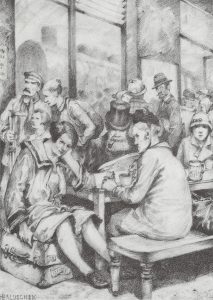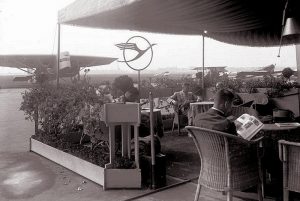Towards a Cultural History of Waiting
By Robin Kellermann, Technische Universität Berlin
Robin Kellermann is a PhD student, research associate and lecturer at Technische Universität Berlin. His research focuses on the cultural history of mobility and transportation as well as digitalization effects in using and experiencing public transportation. The blog post outlines his on-going PhD project about the cultural history of waiting, which is intended both to expose a forgotten mobility aspect and to bridge the gaps between transport history and cultural studies. robin.kellermann@tu-berlin.de
Standing on a platform, waiting for the train to come. Sitting in a departure hall, coping with another delay due to volcanic clouds in the atmosphere. All journeys start with a wait and suddenly, passengers are given time without actually wanting it.
Waiting truly belongs to the greatly overlooked practices of everyday life. Among the many sectors enforcing waiting times, transportation certainly accounts for a most prominent generator. As hardly any other sphere, the timetable-based logics of transportation systems inherently produce spatial, temporal and organizational constraints that cause passengers to be stilled temporarily in situations of waiting before boarding planes or trains.
Despite the phenomenon’s centrality for the transit experience, explicit research on waiting in the transport and mobility context has remained a surprisingly unchallenged and trivialized subject. Instead, particularly transport history – driven by a traditional passion for high-speed technologies or transport artifacts as desired objects of investigation – most often disregarded the complex social, perceptual and spatial spheres underlying temporary stillness, pause or immobility. Concealed by a predominant attention for moving or active subjects, waiting phenomena have rather been treated implicitly in terms of a tacit enemy, regarded as imperative to be defeated by all means.
In short, waiting was (and often is) conceived as a ‘stepchild of mobility’. As a result, we still know remarkably little about the evolution of passengers’ in-transit experiences such as waiting in pre-trip situations at stops or stations, waiting rooms, departure gates or platforms. Though the subjects of waiting and immobility have recently seen increasing attention in fields of human geography (Bissell 2007, Fuller 2014), ethnography (Vannini 2011), literary studies (Gräff 2014, Benz 2013) or, more long-standing, psychology (Yates 1987, Pruyn and Smidts 1998, Taylor 1994), systematic historical examinations of transport-related waiting phenomena rest surprisingly absent (Vozyanov 2014). Consequently, waiting, as Harold Schweizer summarizes, remains a “temporal region hardly mapped and badly documented” (Schweizer 2008, 1).
In order to address this lacuna, my cultural-historical dissertation asks: to what extent do transport-induced waiting situations underlie historical transformation processes regarding physical environments as well as cultural representations and social practices? Seeking to move beyond the tendency in privileging movement over stasis and seeking to enrich traditional transport history narratives towards a more holistic approach of ‘mobility history’ (Mom 2015), I argue for a re-interpretation of 19th century and early 20th century transport modernity through the lens of the era’s unintended and yet massively induced moments of stoppage.
Cultural historian Wolfgang Schivelbusch has influentially examined how the onset of railway travelling comprised a radical transformation of time and space (Schivelbusch 1987). He argues that the rise of railway travelling included a psychological need to adopt a supplementary perceptional and visual attitude, which was to cope with the novel experience of increased speed. However, I think this might just be half of the story. What remains blatantly overlooked in the prevailing focus on speed is the complementary and seemingly mundane experience of awaiting and anticipating the departure for accelerated transfer in a dedicated transitory environment. Thus, in contrast to pre-modern waiting experiences, I argue that the progress of timetable-based railway travel since the 1830s induced a novel mode of in-betweenness, which was however underlying historical transformations regarding spatiality, regulation, perception and duration.
For this reason, my research starts from the hypothesis that parallel to the unfamiliar experience of an unprecedented speed of 50 km/h, it must have been considered similarly unacquainted and novel for mid-19th century travellers to have been contained for 15-30 minutes in an unprecedented spatiality of a waiting room. In other words, equivalent to the experience of speed, the experience of waiting had as well to be ‘learned’ since it could not be grounded on similar previous experiences.
To be clear, waiting undeniably is an anthropological fact and has been experienced ever since for harvest, religious salvation or the return of something or someone! However, transport-related waiting situations did not have to anticipate the abolition of a scarcity or the return of something or someone, but rather the mundane operational necessity to assimilate and synchronize in a technical apparatus. Compared to traditional waiting situations, such systemic waiting was less existential (and even joyful), but nevertheless psychologically demanding because perception of and reflection about time inevitably became the focus of attention.
Based on the assumption that the comparably novel situation of systemic waiting demanded for novel architectural as well as psychological solutions, my research project will uncover the evolutionary cycles of these solutions with the help of two intermingled streams of analysis. First, by retracing diachronically the ways in which architects and planners conceptualized and designed waiting environments. Second, through a diachronic analysis of how passengers made sense of such transitory short stays. Touching mainly upon the cases of German and English railway stations, I finally aim to examine the elusive phenomenon of waiting by retracing the ways of how moments of transitory short stay have been framed spatially and technically and by retracing the ways waiting has been perceived and performed as a social practice (ranging from boredom to proud or even joyful representation).

A fleeting glance on the first century of organizing rail transportation already offers hints that not only locomotives have a long history but also the operational aspects of ‘storing’ passengers temporarily before actually boarding the trains. For the longest time of the 19th century, the temporarily and interim stilling of passengers in dedicated environments was considered an operational precondition for the organization of mass transportation. While the pioneering phase of railway travelling saw rather informal ways of waiting, the following decades saw an increasing level of formalizing the wait in ever growing spatially bound compartments, establishing a waiting imperative (similar to today’s handling at airports) that materialized in the spacious, luxurious and richly decorated waiting rooms inside railway stations of major metropolises. Railway passengers in e.g. France, Germany or Austria were not allowed to step on the platforms individually but were forced to wait and anticipate the departure in a transitory environment right next to the train (see fig.1). This waiting imperative, serving as a transition zone for synchronizing passengers to the technical regime of railways and thus streamlining the organization of speed, was subsequently criticized by passengers and was compensated by an increasing provision of service and comfort, which satisfied the demand for what Schivelbusch called ‘substitutional landscapes’ or strategies that allowed for filling time more meaningfully.
However, the turn of the century marked a turning point in both negotiating and perceiving the wait, reflecting a co-evolutionary atmosphere of problematizing the waiting imperative from different angles. While on the one hand architects, inspired by processes of industrial organization, obsessively followed the dogma of replacing controllable stasis (waiting rooms) by infrastructures of continuous flow (concourse), passengers on the other hand felt enough routinized to navigate individually and increasingly problematized the waiting imperative, not least against the background of an industrializing society that had put time efficiency on top priority.
Drafting a first sketch of an evolutionary cycle, waiting in the early 19th century can be thought of having comprised a representational aspect and thus may have been connoted more positively (as it is today). Moreover, proven by a major shift in the planning of station buildings, it was hardly before the turn of the century that waiting became problematized as to be avoided by any means.

To that day, utopian dreams of seamless flows have not (yet) been materialized. Moreover, apart from jet set elite travel, in the future we are supposed to be even more stuck in traffic or to have to cope with delays due to infrastructural or energetic scarcities. Hence, waiting remains a congenital twin aspect of both organizing and experiencing physical transportation. In acknowledging the relationship between movement and stillness, it may now be required to historicize these aspects much more. Since speed and movement are comparably well researched, historicizing moments of stillness may therefore become a fruitful endeavor comprising the potential of unveiling the story of one of modernity’s most constitutive temporal phenomena.
References
Benz, Nadine. (Erzählte) Zeit des Wartens: . Göttingen: V&R unipress, 2013.
Bissell, David. „Animating Suspensation: Waiting for Mobilities.“ Mobilities, July 2007: 277-298.
Fuller, Gillian. „Queue.“ In The Handbook of Mobilities, von P., Bissell, D., Hannam, K., Merriman, P., & Sheller, M. (Eds.). Adey, 205-213. London und New York: Routledge, 2014.
Gräff, Friederike. Warten. Erkundungen eines ungeliebten Zustands. Berlin: Ch. Links Verlag, 2014.
Mom, Gijs. The Crisis of Transport History: A Critique, and a Vista. Bd. vol. 6, in Mobility in History (T2M Yearbook 2015), by Gijs Mom, Dhan Zunino Singh and Christiane Katz eds. Kyle Shelton, 7-19. Oxford: Berghahn, 2015.
Pruyn, Ad, and Ale Smidts. “Effects of waiting on the satisfaction with the service: Beyond objective time measures.” International Journal of Research in Marketing, October 1998: 321-334.
Schivelbusch, Wolfgang. The Railway Journey: The Industrialization of Time and Space in the 19th Century. Berkeley: University of California Press, 1987.
Schweizer, Harold. On Waiting. London: Routledge, 2008.
Taylor, Shirley. „Waiting for Service: The Relationship Between Delays and Evaluations of Service.“ Journal of Marketing, 58(2) 1994: 56-69.
Vannini, Phillip. „Mind the gap: The tempo rubato of dwelling in lineups.“ Mobilities, 2011: 273-299.
Vozyanov, Andrey. „Approaches to Waiting in Mobility Studies: Utilization, Conceptualization, Historicizing.“ Mobility in History, 2014: 64-73.
Yates, John. WHY ARE WE WAITING? An analysis of hospital waiting lists. Oxford: Oxford University Press, 1987.
